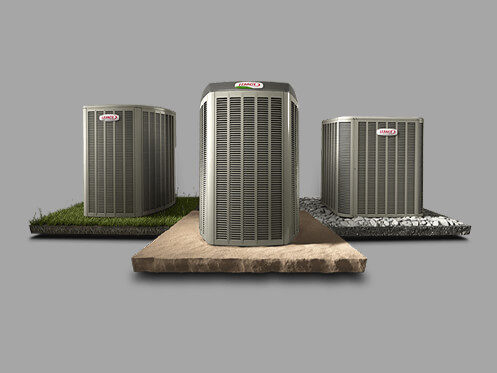If you’re ready to invest in a home air conditioning system, then your head is probably spinning with all the options on the market today. It’s crucial that you take a breath and learn about the various types of air conditioning systems that are available. This way, you can select the appropriate options to fit your needs.
Split Systems
The most popular type of air conditioning system on the market today is the split system. This system is comprised of two units, one that sits indoors and one that sits outdoors. The entire system is controlled by one thermostat, and you’ll need to have ductwork running throughout the walls of your home for it to circulate air.
Packaged Systems
For homes that don’t have enough space to house an indoor unit, there are packaged systems. These tend to be more expensive but come with the luxury of having all the system components in one convenient unit. The package unit sits outside and pipes cooled air indoors through the ductwork that runs throughout your home. This outdoor unit can be placed at ground level next to your home or even in a flat room, if necessary.
Ductless Mini-Split Systems
The last option is the ductless mini-split system. This is comprised of a number of individual wall-mounted units that are connected to an outdoor compressor unit via copper tubing. Each unit comes with its own thermostat and controls so that you can enjoy different temperatures through the rooms in your home.
The main benefit of ductless mini-split systems is that they don’t require any ductwork. Where split and packaged air conditioning systems utilize ductwork to move the cooled air throughout the rooms in your home, ductless mini-splits systems create cooled air at the wall-mounted unit.
Ductwork vs. No Ductwork
One of the most important factors to consider when choosing the ideal air conditioning system for your home is whether or not you have existing ductwork. Unless your home is in the process of being built where the air conditioning pros have access to the areas behind the wall, it can get very costly to install ductwork in an existing home.
Installing ductwork in an existing home would require cutting into the walls. This means patching up all the walls and repainting your rooms. For this reason, it’s not highly recommended to put a packaged or split air conditioning system into an existing home that has no ductwork. Instead, ductless mini-split units are going to be the ideal option for this type of situation.
On the other hand, if you have existing ductwork for your furnace, you can opt for a packaged or split air conditioning system. These options are going to be much cheaper than investing in the ductless mini-split system. Once you determine the right type of system you’re going to need for your home, it’s time to consider the necessary cooling output.
Avoiding an Oversized AC System
One of the biggest mistakes that homeowners make when it comes to picking out an air conditioning unit for their home is choosing one that is too big. At first, this may not seem like a problem. In fact, it may seem as if you’re erring on the side of convenience in purchasing a system that you know will produce more cooling power than the square footage that your home requires.
However, this can cause many different problems. The first is that you’ll be overspending on your cooling bills because your air conditioning system will be running around the clock. It will be a constant on and off battle as it cools your home down in a few minutes.
One of the biggest problems you’ll face is high humidity levels. When your air conditioning system is only running in short blips, it’s unable to remove a large amount of excess humidity from the air inside of your home. This can lead to your home feeling warmer and stickier than usual.
Discover the Appropriate AC Size
The main deciding factor of the air conditioning system that you’ll want to purchase is the square footage of your home. A general rule of thumb is to multiply the square footage of your home by 35. This will give you the BTUs that your air conditioning system will need to be rated.
Apart from the square footage of your home, you’ll need to consider the heat gain/loss and environmental circumstances. For example, you’ll need to take into account whether the majority of the rooms in your home are very sunny or heavily shaded. The more people that occupy your home, the bigger your air conditioning system will need to be.
Most professionals will use a formal calculation referred to as the Manual J to factor in these other inputs to get you the proper sizing for your air conditioning system. This calculation will also take into account your regional climate.
Desired Features
Once you know the type and size of the air conditioning system that you’ll need for your home, it’s time to get to the fun part. There are many different features that are available in today’s home air conditioning systems. There are a few that you’ll want to ensure that your new system will have.
First is a high SEER rating. SEER stands for seasonal energy-efficiency ratio and helps to relay the energy-efficiency of a particular air conditioning system model. The higher the SEER rating, the more energy-efficient the air conditioning system. However, it’s vital to consider the cost as well. You could purchase the highest SEER rating on the market and never recoup the extra investment in energy savings for decades to come.
The next must-have feature is a variable-speed motor. Most older air conditioning systems have a single-speed motor where they run full speed or not at all. This can lead to temperature fluctuations throughout your home and more energy consumption. Variable speed motors allow you the ability to control the amount of air that flows through your system. This permits less strain on your system and lowers your energy usage.
Having a smart thermostat is another must-have feature. This allows you to adjust your home’s thermostat from anywhere that your smartphone has connectivity. You can even program a unique schedule of different temperatures throughout the week so that you can have a more energy-efficient operation of your system.
Lastly, having the option of zone heating can be a big advantage for homeowners who have large homes. A regular air conditioning system may have trouble maintaining a comfortable temperature throughout your entire home, especially if you have multiple floors.
Zone heating allows you to have separate climate control for various rooms throughout your home. Instead of setting one temperature for your whole home, you can set a lower temperature for your upper level that receives more sunlight throughout the day. Zone heating allows you to make your entire home comfortable for your family to enjoy, no matter how hot it gets outside.
Outstanding AC Installation
We Care Plumbing, Heating, and Air are proud to provide all of our Murrieta neighbors with outstanding air conditioning system installation. We also provide quality heating, cooling, plumbing, and indoor air quality services. Just pick up the phone and give us a call today!







